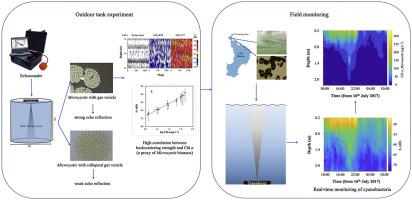Water Research ( IF 12.8 ) Pub Date : 2020-06-22 , DOI: 10.1016/j.watres.2020.116091 Ilia Ostrovsky 1 , Sha Wu 2 , Lin Li 3 , Lirong Song 3

|
Harmful cyanobacterial blooms pose a serious environmental threat to freshwater lakes and reservoirs. Investigating the dynamics of toxic bloom-forming cyanobacterial genus Microcystis is a challenging task due to its huge spatiotemporal heterogeneity. The hydroacoustic technology allows for rapid scanning of the water column synoptically and has a significant potential for rapid, non-invasive in situ quantification of aquatic organisms. The aim of this work is to develop a reliable cost-effective method for the accurate quantification of the biomass (B) of gas-bearing cyanobacterium Microcystis in water bodies using a high-frequency scientific echosounder. First, we showed that gas-bearing Microcystis colonies are much stronger backscatterers than gas-free phytoplanktonic algae. Then, in the tank experiments, we found a strong logarithmic relationship between the volume backscattering coefficient (sv) and Microcystis B proxies, such as Microcystis-bound chlorophyll a (Chl aMicro) and particle volume concentration. The sv/B ratio remained unchanged over a wide range of B concentrations when the same source of Microcystis material was used. Our measurements in Lake Dianchi (China) also revealed strong logarithmic relationship between sv and Chl aMicro. The biomass-calibrated echosounder was used to study the diurnal variability of Microcystis B in the lake. We found a sharp increase in the cyanobacterium B and sv/Chl aMicro ratio near the water surface during the daytime and more uniform distribution of these parameters during the nighttime. We argue that the variations in B and sv/Chl aMicro ratio could be associated with temporal changes in thermal stratification and turbulent mixing. Our data suggest that the sv/Chl aMicro ratio positively correlates with (i) the percentage of larger colonies in population and/or (ii) the content of free gas in cells. The last properties allow Microcystis colonies to attain rapid floating, which enables them to concentrate at the water surface at conducive ambient conditions. The sv/Chl aMicro ratio can be a new important variable reflecting the ability of Microcystis colonies to migrate vertically. Monitoring of this ratio may help to determine the early warning threshold for Microcystis scum formation. The proposed acoustic technology for in situ quantification of Microcystis biomass can be a powerful tool for accurate monitoring and assessment of this cyanobacterium at high spatiotemporal resolution in water bodies.


























 京公网安备 11010802027423号
京公网安备 11010802027423号